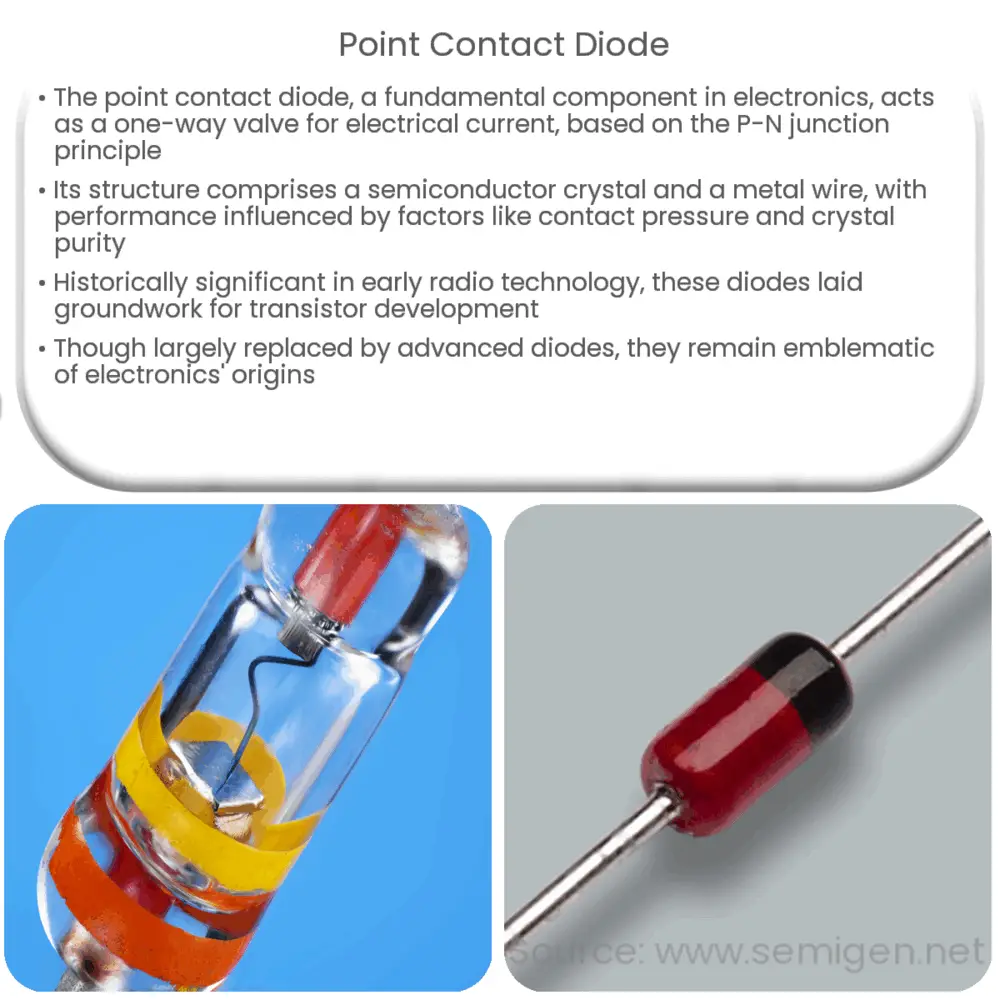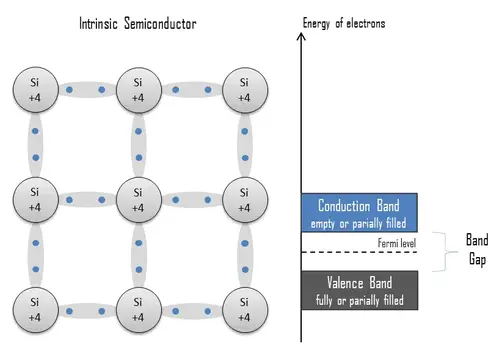Point contact diodes are simple semiconductor devices that allow current flow in one direction, used in radio detection, signal mixing, and pulse shaping.

Point Contact Diode: An Essential Component in Electronics
Introduction
The point contact diode is a fundamental component in the world of electronics. With its simple structure and remarkable performance, it has played a crucial role in the development of various electronic devices. In this article, we will explore the fundamental principles behind point contact diodes, their structure, and applications.
What is a Point Contact Diode?
A point contact diode, also known as a crystal diode or cat’s whisker diode, is a type of semiconductor diode that relies on the electrical properties of a small point contact between a metallic wire and a semiconductor crystal. The diode’s primary function is to allow current to flow in one direction while blocking it in the opposite direction, essentially acting as a one-way valve for electrical current.
How Does a Point Contact Diode Work?
Point contact diodes operate based on the principles of the P-N junction. A P-N junction is formed by joining a piece of P-type semiconductor material (material with an excess of holes or positive charge carriers) with a piece of N-type semiconductor material (material with an excess of electrons or negative charge carriers). When these two materials come into contact, electrons from the N-type material flow into the P-type material, creating an electric field that prevents further electron flow.
In a point contact diode, the P-N junction is formed by touching a metal wire (often called the cat’s whisker) to a small spot on a semiconductor crystal. The metal wire is made from a material with a higher work function than the semiconductor, such as gold or platinum. The contact point between the wire and the crystal creates a local P-N junction, and the diode exhibits rectifying behavior, allowing current to flow in one direction but not the other.
Structure of a Point Contact Diode
The basic structure of a point contact diode consists of a semiconductor crystal, a metal wire, and a base to hold the components together. The semiconductor crystal is typically made from materials like silicon or germanium, which have desirable electronic properties. The metal wire, or cat’s whisker, is carefully positioned to make contact with the crystal at a precise location.
A point contact diode’s performance can be influenced by various factors, including the pressure applied at the contact point, the material of the semiconductor, and the crystal’s purity. By carefully controlling these factors, the diode’s electrical characteristics can be fine-tuned for specific applications.
Applications of Point Contact Diodes
Point contact diodes have been used in a wide range of applications since their invention. Some common uses include:
- Radio signal detection: Point contact diodes have been historically used in early radio receivers to detect and demodulate amplitude-modulated (AM) radio signals.
- Signal mixing: Point contact diodes can be used in mixer circuits to combine two or more input signals, generating new frequencies as a result.
- Switching and pulse shaping: Due to their fast switching capabilities, point contact diodes have found applications in high-speed digital logic circuits and pulse shaping networks.
Advantages and Disadvantages of Point Contact Diodes
Point contact diodes offer several advantages and disadvantages, which make them suitable for specific applications:
Advantages
- Simple structure: Point contact diodes have a straightforward design, making them easy to manufacture and understand.
- Fast switching: Due to the small contact area, point contact diodes can switch between conducting and non-conducting states quickly, making them suitable for high-frequency applications.
- Low capacitance: The small junction area of a point contact diode results in low junction capacitance, which allows for better performance in high-frequency applications.
Disadvantages
- Low current handling: Point contact diodes have a limited current-carrying capacity due to their small junction area. As a result, they are not suitable for high-power applications.
- Sensitivity to mechanical stress: The performance of point contact diodes can be greatly affected by mechanical stress, making them less reliable in certain environments.
- Obsolete for many modern applications: Point contact diodes have been largely replaced by other types of diodes, such as junction diodes and Schottky diodes, which offer better performance and reliability in most applications.
Historical Significance of Point Contact Diodes
Point contact diodes played a significant role in the early days of electronics, particularly in the development of radio technology. They were used in crystal radio sets, which were among the first wireless receivers. These simple devices allowed people to listen to radio broadcasts without the need for external power, relying on the energy of the radio waves themselves to produce sound.
The invention of the transistor, which also has its roots in point contact technology, marked a turning point in the field of electronics. The point contact transistor, a predecessor to the modern-day bipolar junction transistor, was built on the same principle as point contact diodes. The development of the transistor revolutionized electronics, paving the way for the miniaturization and increased functionality of electronic devices.
Conclusion
Although point contact diodes have been largely replaced by more advanced diode technologies, they remain an essential part of electronics history. Their simplicity, ease of manufacturing, and unique properties enabled early radio technology and laid the foundation for the development of the transistor. Today, point contact diodes still find use in niche applications and serve as a reminder of the humble beginnings of modern electronics.



